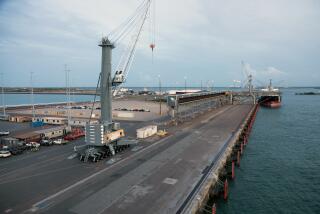Market Scene : Transfusing Life Into a Stagnant Shanghai : After decades of neglect and abuse, Beijing is looking at the old city as a prime spot for an ambitious foreign investment zone.
- Share via
SHANGHAI — After inheriting the rich, sophisticated, wicked old Shanghai of pre-revolutionary days, China’s Communists spent decades bleeding this metropolis of money and skilled personnel.
The resources went to build up other regions, while this onetime haven of foreign influence and freewheeling capitalism was left to stagnate in leftist orthodoxy and rigid central planning.
But in a strategic policy shift that could restore Shanghai’s greatness, plans are afoot to transform an undeveloped section of this city into China’s biggest foreign investment zone.
The focus is on a largely rural 140-square-mile district called Pudong that lies across the Huangpu River from the old European-style buildings of Shanghai’s famous Bund. Bounded on the west by the Huangpu and on the northeast by the Yangtze River, the district will use new Yangtze shipping berths to send products across the Pacific and around the world.
The goal is to build an industrial, commercial and financial center that would play a key role in Chinese modernization for the 1990s and beyond.
Planners believe that success with this plan, the most ambitious urban development scheme ever attempted by China, would help trigger growth throughout the Yangtze River Valley, home to several hundred million people.
Pudong development, discussed for years, has been pushed forward with new urgency in recent months, especially since Premier Li Peng endorsed the project during an April visit to Shanghai.
The decision to accelerate development of Pudong “is an event of strategic significance both to Shanghai and the whole country,” Li declared.
Pudong development is backed by a wide spectrum of the Beijing leadership, including market-oriented reformers and more orthodox hard-liners.
Li and the conservatives associated with him, while supporting some modification of China’s economic system, also wish to preserve a major role for central planning and avoid significant political change. By endorsing special policies in Pudong, these leaders can present an image of moderation and encourage badly needed foreign investment without needing to support new nationwide reforms.
For reformers, on the other hand, Pudong helps keep alive hopes for fundamental change. Measures proven successful here may eventually be enacted much more broadly.
Plans for Pudong are themselves an expansion of successful policies implemented during the past decade in southern China’s outward-looking “special economic zones.”
The most famous of these zones is Shenzhen, which in the past decade has grown from a sleepy village near the Hong Kong border into a booming city of high-rise buildings and new factories.
“Things started out with Shenzhen in the 1980s,” commented Sha Lin, head of the Pudong Development Office. “In the 1990s, the action should be here in China’s economic heartland. . . . If we want to really solve Shanghai’s problems, take a step forward in our most important economic region and push forward reform and openness, carrying out this plan is the best thing to do.”
The new focus on Pudong also involves personalities in the top leadership. Communist Party General Secretary Jiang Zemin, 64, served previously as mayor and party chief of Shanghai. The city’s current mayor, Zhu Rongji, 61, is widely viewed as one of China’s rising political stars. Success in Pudong could help both men’s careers.
Sha said that Pudong is important as a testing ground.
“We want to do some relatively big experiments (that) cannot be done in an ordinary small place,” he said. “There are lots of things here that represent our tomorrow.”
One of the most dramatic ideas planned for Pudong is creation of a free trade zone loosely modeled after Hong Kong. This subdistrict, in an area called Waigaoqiao, is to be fenced off from the rest of the city as a special zone where factories can ship in raw materials without paying customs duty and re-export finished products. Chinese citizens would need special permits to enter this zone, and its economic life would be conducted with hard currency rather than the non-convertible renminbi , or “people’s money,” of China.
Other special policies in Pudong will include permission for foreign companies to purchase land-use rights valid for 50 to 70 years, engage in wholesale and retail sales, and provide banking services, Sha said.
Some of these policies, which are intended to be at least as attractive as those offered in any of China’s special economic zones, may eventually be adopted more widely, Sha said.
“We want to use this area to develop, to experiment and then to spread these things to the main part of Shanghai,” he said. “Now, the central government has given this policy only to the Pudong side. But I think our purpose isn’t only on this side. . . . I think its value is as a vanguard, (and) a vanguard’s purpose is to lead the way.”
A Western diplomat in Shanghai, who spoke on condition he not be identified, said he believes Pudong “is important in that for the first time, the central leadership has been willing to bring one of these large (foreign) investment zones into a center of Chinese industry.”
This diplomat noted, however, that “there are lots of problems with Pudong.”
“One, of course, is financing,” he said. “Where are they going to come up with the money to do something this ambitious? They’re going to have to rely on foreign capital to assist, but it’s not clear at this point what foreigners are going to be willing to come forward with investment to help them out with infrastructure. . . . I think ‘wait and see’ is the operative mode here. . . . There are people who are even more skeptical of the project, who have seen things come and go. They are profoundly skeptical.”
This diplomat added, however, that he does not agree with those who view all the recent talk about Pudong just as empty words aimed at presenting a reformist image to the outside world.
“I don’t think it was something they just cooked up to pacify foreigners or to convince foreigners that China is serious about continuing to open up to the outside,” he said.
China seems to recognize that its first job in promoting Pudong is to build enough infrastructure to make foreigners take the project seriously.
Among the most important projects already under construction is a six-lane suspension bridge across the Huangpu that will link old districts of Shanghai with Pudong, now accessible only by ferry and two narrow tunnels.
The central government has pledged about $1.4 billion for construction of other Pudong infrastructure over the next five years, including work on a second Huangpu bridge, key roads, utilities, modern telephone links, schools, hospitals and stores.
But plans on the drawing board require much more: At least $5 billion of investment in infrastructure by 1995, with a similar amount required in the second half of the decade. It is not clear whether this much money can be raised.
Sha insisted that, at least in the next few years, the problem is not too great. In addition to central government funds, Shanghai will put more than $1 billion of city revenues into Pudong during the next five years, he said. Loans are expected from Chinese banks, and planners hope foreign governments and international lending agencies will provide long-term, low-interest loans, he added.
The main focus of development for the next decade would be on infrastructure and industry. It is only in the first decade of the next century that planners hope for major financial and commercial districts to develop on the Pudong side of the Huangpu River, immediately across from Shanghai’s historic financial center.
But Pudong development is already directly linked with plans to open a new securities exchange center in the old part of Shanghai by the end of this year.
During the 1980s, Shanghai saw the growth of markets in national treasury bonds and so-called “enterprise bonds,” issued primarily by state-owned companies, plus small exchanges handling over-the-counter trading in the stocks of seven Shanghai companies. The new securities exchange would promote expansion of these operations.
Authorities have said that Chinese firms and Sino-foreign joint ventures set up in Pudong will be allowed to issue bonds or stocks for trade on this securities exchange.
Sha expressed confidence that if China develops the needed infrastructure for Pudong, foreign investors will come in due course.
“Presently, they still don’t understand,” Sha said. “Many are taking a wait-and-see attitude. I think this is natural.”
Sha said that since the Pudong Development Office was established on May 3, about 3,000 potential investors from overseas have already made inquiries. About half the inquiries have come from Taiwanese business people, about 15% from Hong Kong investors and about 10% from Americans, he said.
Sha acknowledged that if Pudong is successful in sparking additional reforms, some of the special policies intended to attract foreign investors here may eventually apply elsewhere as well.
But he insisted that that possibility shouldn’t keep people away.
“This is the place where at present we’re establishing the best (investment policy) environment in China,” he said. “You can do things you can’t do elsewhere. You can get established, get your feet on the ground. You’re establishing a bridgehead. You can make money and be in position for the future.”
More to Read
Sign up for Essential California
The most important California stories and recommendations in your inbox every morning.
You may occasionally receive promotional content from the Los Angeles Times.











